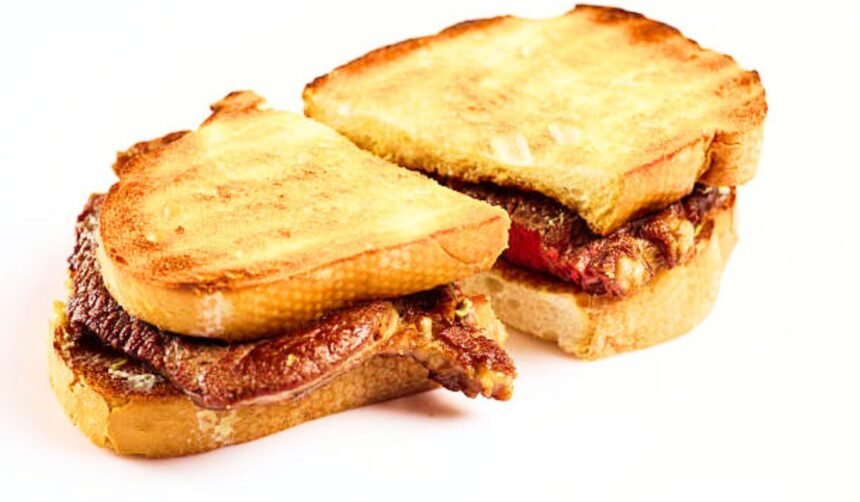The mighty steak sandwich is enjoyed worldwide in many delicious forms. While bread, meat, and cheese might seem simple, steak sandwiches take on unique traits across cultures.
From banh mi in Vietnam to bifanas in Portugal, chivitos in Uruguay and more, these handheld meals reveal local flavors and customs.
In this global tour, we’ll highlight popular international steak sandwiches, discuss how they differ, and explore their cultural significance. Read on for a passport to global steak sandwich deliciousness.
Vietnam – Banh Mi
The banh mi is Vietnam’s take on the French baguette sandwich, filled with local ingredients. Thin slices of seasoned grilled meat, including steak, are paired with pickled vegetables, cucumber, cilantro, chili sauce, and rich pâté or mayo. The fusion sandwich shows both French colonial and Vietnamese influences.
Key Features:
- French bread
- Steamed, grilled or roasted marinated steak
- Vegetable pickles
- Spicy chilies
- Cilantro
- Maggi seasoning
Cultural Significance: Banh mi cheaply fed factory workers and became part of Vietnamese identity. The sandwich adapts French ingredients to local tastes.
Brazil – Bauru
Hailing from São Paulo, the Bauru sandwich features tender steak as the star filling. Steak slices are combined with tomato, pickled cucumber, and mozzarella cheese between French rolls slathered with butter. It offers pure steak sandwich deliciousness with a Brazilian twist.
Key Features:
- French bread rolls
- Thin sliced rump steak
- Tomato
- Pickled cucumber
- Mozzarella
- Butter
Cultural Significance: Named after a city in São Paulo state, the Bauru represents Brazilian pride in excellent steaks. The pickles and cheese reveal immigration influences.
Portugal – Bifana
A bifana showcases thin slices of juicy grilled pork steak drowned in a tangy mustard or piri piri hot sauce and piled into a bread roll. Optional extras like fries or cheese build on the classic. Bifanas are a popular Portuguese snack.
Key Features:
- Pork steak
- Mustard or pepper sauce
- Crusty roll
Cultural Significance: These cheap, filling sandwiches sustained workers and travelers. The sauce represents Portuguese flavors.
Greece – Bifteki
Ground meat kebabs known as bifteki inspired this Hellenic sandwich. Bifteki meat patties, onions, tomatoes and fries are packed into fresh bread or pitas with yogurt sauce. Traditional Greek flavors like oregano season the meat.
Key Features:
- Ground beef patties
- Onions
- Tomatoes
- Potatoes
- Tzatziki yogurt sauce
- Pita or bread
Cultural Significance: Bifteki sandwiches showcase Greece’s Mediterranean ingredients and ground meat cooking techniques in a handheld form.
Argentina – Lomito
Lomitos feature thin slices of tender lomo beef topped with cheese, tomatoes, lettuce or other veggies in baguettes or sandwich bread. Versions like the lomito completo pile on extras like ham, bacon, eggs or fries for a hearty sandwich.
Key Features:
- Lomo steak slices
- Tomatoes
- Greens
- Cheese
- Baguette
Cultural Significance: These sandwiches celebrate Argentina’s prized beef and local ingredients. Extras like fries show Argentine appetites.
Uruguay – Chivito
The national sandwich of Uruguay, the chivito stacks sliced churrasco steak with mozzarella, tomatoes, bacon, olives, hard-boiled egg, ham, lettuce and more between bread. Oftentimes served with fried potatoes, this hearty sandwich is protein packed.
Key Features:
- Grilled churrasco steak
- Mozzarella
- Bacon
- Egg
- Ham
- Fries
- Bread rolls
Cultural Significance: Chivitos showcase Uruguayan beef along with Italian and Spanish immigrant ingredients like olives, cheese and ham. The generous size reflects local culture.
South Korea – Gurak Toast
In Korea, thinly sliced marinated beef like bulgogi is piled onto thick slices of toasted white bread with vegetables. Sweet pickled radishes and spicy gochujang sauce provide Korean flavors. The simple Gurak Toast is a popular snack.
Key Features:
- Bulgogi beef
- Toasted bread
- Pickled radish
- Gochujang sauce
Cultural Significance: Gurak toast adapts Korean flavors like bulgogi and gochujang to European toast for a quick, hearty sandwich.
Cuba – Pan Con Bistec
In Cuba, thinly shaved palomilla steak is layered into crusty Cuban bread with fried onions, tomato and seasoned with lime juice and hot sauce. The sandwich is a staple homecooked meal on the island.
Key Features:
- Marinated, pounded palomilla steak
- Cuban bread
- Onions
- Tomato
- Lime
- Hot sauce
Cultural Significance: Pan con bistec uses economical ingredients to create a satisfying Cuban steak sandwich. The marinade and hot sauce incorporate Cuban seasonings.
Mexico – Tortas Ahogadas
In these Mexican sandwiches, crispy fried cubed steak is doused in a fiery chile-tomato sauce and stuffed into birote bread rolls. Onions, beans, cheese, and avocado cream provide cool contrast. They’re “drowned” sandwiches.
Key Features:
- Fried cubed steak
- Chile sauce
- Birote rolls
- Onions
- Beans
- Avocado
- Cheese
Cultural Significance: Originating in Guadalajara, these messy, spicy sandwiches showcase Mexican flavors and ingredients. Their stuffed size reflects the culture.
Worldwide Customization
While traditional versions abound, steak sandwiches worldwide also get customized with local ingredients. Globalization has spread ideas and allowed fun fusions. Some creative examples include:
- Philly cheesesteak banh mi with sriracha and cilantro
- Chimichurri bifanas with steak and pickled peppers
- Gurak toast with bulgogi and Swiss cheese
- Bauru with bacon, egg, and avocado
- Bifteki with harissa yogurt sauce
The canvas of bread, meat, and cheese invites endless innovation. Steak sandwich recipes spread globally, melding customs. In every bite, we can taste culture.




